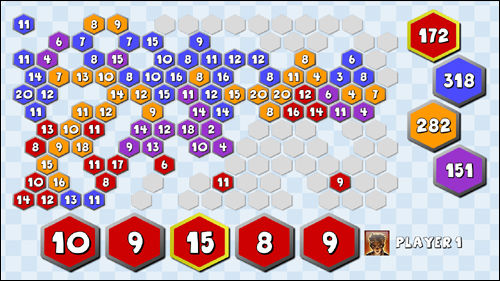Archive
• June 2005• July 2005
• August 2005
• September 2005
• October 2005
• November 2005
• December 2005
• January 2006
• February 2006
• March 2006
• April 2006
• May 2006
• June 2006
• July 2006
• August 2006
• September 2006
• October 2006
• November 2006
• December 2006
• January 2007
• February 2007
• March 2007
• April 2007
• May 2007
• June 2007
• July 2007
• August 2007
• September 2007
• October 2007
• November 2007
• December 2007
• January 2008
Saturday, August 04, 2007

Proximity HD is a simplified strategy game for up to four players. You have five tiles in your hand at any given time, each tile with a number on it from 1 to 20, representing the strength of that tile.
Each turn, you can place a tile on any empty space on the hex-based board. Once that tile is placed, it affects any tiles surrounding it. Tiles that belong to the same team are reinforced by 2 points, enemy tiles with a smaller number than the tile placed are captured, and enemy tiles with the same or higher numbers than the placed tile have their strength reduced by two points.
After the board is filled, the scores on all the tiles are added up and the team with the highest score is considered the winner. There are plenty of tweaks and settings to tinker with, for example computer AI, winning conditions, map and even gameplay types.
Name: Proximity HD
Developer: Brian Cable
Category: Strategy
Type: Browser
Labels: pu0807
Recent Comments
Recommendations
2007 © Independent Gaming.
